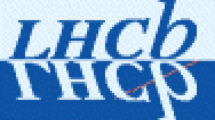Abstract.
A parameter-free statistical model is used to study multiplicity signatures for coherent production of charged pairs of parabosons of order p = 2 in comparison with those arising in the case of ordinary bosons, p = 1. Two non-negative real parameters arise because “ab” and “ba” are fundamentally distinct pair operators of charge “ + 1”, A-quanta and charge “-1”, B-quanta parabosons. In 3D plots of \({P_{m}}(q)\equiv\) “the probability of m paraboson charged pairs + q positive parabosons” versus \(\langle n\rangle \) and \(\langle n^2\rangle \), the p = 1 curve is found to lie on the relatively narrow 2D p = 2 surface.
Similar content being viewed by others
References
H.S. Green, Phys. Rev. 90, 270 (1953); D.V. Volkov, Sov. Phys.-JETP, 11, 375 (1960); c.f. W. Pauli, Handbuch der Physik, Vol. 24, p. 113 of Sect. 14 (1934); C.P. Enz, A scientific biography of W. Pauli (Oxford U. Press 2002), p. 128
O.W. Greenberg, A.M.L. Messiah, Phys. Rev. B 136, 248 (1964); B 138, 1155 (1965)
Y. Ohnuki, S. Kamefuchi, Quantum field theory and parastatistics (Univ. Press of Tokyo 1982)
C.P. Wang, Phys. Rev. 180, 1463 (1969). Wang plotted P m (q) for q=0 versus the equivalent, mean number of charged prongs \(\langle n_{s}\rangle =2\langle n\rangle +2 = \langle n_{c}\rangle \) (Horn-Silver). Figure 1a in Wang’s paper shows the laboratory kinetic energies of the data points
D. Horn, R. Silver, Phys. Rev. D 2, 2082 (1970)
D. Bhaumik, K. Bhaumik, B. Dutta-Roy, J. Phys. A 9, 1507 (1976); J.R. Klauder, B.-S. Skagerstam, Coherent States (World Sci. Pub. Co., Singapore 1985), p. 43-48; G.S. Agarwal, J. Opt. Soc. Am. B 5, 1940 (1988)
S. Jing, C.A. Nelson, J. Phys. A 32, 4131 (1999)
D. Horn, R. Silver, Annals of Phys. (NY) 66, 509 (1971), and references therein; D. Horn, Phys. Rep. 4, 1 (1972); D. Horn, F. Zachariasen, Hadron physics at very high energies (W.A. Benjamin, Reading, MA 1973)
T. Sjostrand, M. Bengtssson, Comp. Phys. Comm. 43, 367 (1987); G. Marchesini, B.R. Webber, Comp. Phys. Comm. 67, 465 (1992); S. Jadach, Z. Was, R. Decker, J.H. Kuhn, Comp. Phys. Comm. 76, 361 (1993); S. Jadach, B.F.L. Ward, Z. Was, Comp. Phys. Comm. 124, 233 (2000); B.F.L. Ward, S. Jadach, Acta Phys. Polon. B 33, 1543 (2002); L. Lonnblad, Comp. Phys. Comm. 71, 15 (1992); T. Sjostrand, P. Eden, C. Friberg, L. Lonnblad, G. Miu, S. Mrenna, E. Norrbin, Comp. Phys. Comm. 135, 238 (2001)
Perturbative Quantum Chromodynamics, edited by A.H. Mueller (World Sci. Pub. Co., Singapore 1989), and references therein; Yu. L. Dokshitzer, V.A. Khoze, A.H. Mueller, S.I. Troyan, Basics of Perturbative QCD, edited by J. Tran Thanh Van (Editions Frontieres, Gif-sur-Yvette 1991); J.C. Collins, D.E. Soper, Ann. Rev. Nucl. Part. Sci. 37, 383 (1987); R.K. Ellis, W.J. Stirling, B.R. Webber, QCD and collider physics (Cambridge Uni. Press 1996); B. Andersson, G. Gustafson, G. Ingelman, T. Sjostrand, Phys. Rep. 97, 31 (1983); B. Andersson, The Lund model (Cambridge U. Press 1997); L.L. Frankfurt, M.I. Strikman, Phys. Rep. 160, 235 (1988); L.N. Lipatov, Phys. Rep. 286, 131 (1997); I. Dremin, J.W. Gary, Phys. Rep. 349, 301 (2001); S. Catani, F. Krauss, R. Kuhn, B.R. Webber, JHEP 0111, 63 (2001); C.F. Berger, T. Kucs, G. Sterman, Phys. Rev. D 68, 014012 (2003); A. Hebecker, Phys. Rep. 331, 1 (2000); E.A. De Wolf, J. Phys. G 28, 1023 (2002)
H.A. Kastrup, Nucl. Phys. B 1, 309 (1967); H. Gemmel, H.A. Kastrup, Z. Phys. 229, 321 (1969); Nucl. Phys. B 14, 566 (1969)
Mathematica, Version 4.2, Wolfram Research, Inc. (Champaign, IL)
Fractional Statistics and Anyon Superconductivity, edited by F. Wilczek (World Sci. Pub. Co., Singapore 1990); A. Khare, Fractional statistics and quantum theory (World Sci. Pub. Co., Singapore 1997)
M.G. Albrow, A. Rostovtsev, hep-ph/0009336; V. Khoze, A.D. Martin, M. Ryskin, Eur. Phys. J. C 14, 525 (2000); hep-ph/0207313; A. De Roeck, V. Khoze, A.D. Martin et al. , Eur. Phys. J. C 25, 391 (2002); CDF Collab., D. Acosta et al. , hep-ex/0311032; TOTEM Collab., http://totem.web.cern.ch/Totem
DAMA Collab., R. Bernabei et al. , Riv.N. Cim. 26, 1 (2003); CDMS Collab., R. Abusaidi et al. , Phys. Rev. Lett. 84, 5699 (2000); EDELWEISS Collab., A. Benoit et al. , Phys. Lett. B 513, 15 (2001); IGEX Collab., H. Morales et al. , Phys. Lett. B 489, 268 (2000); HDMS Collab., H.V. Klapdor-Kleingrothaus et al. , Nucl. Phys. Proc. Supp. 110, 364 (2002); ZEPLIN Collab., J. Dawson et al. , Nucl. Phys. Proc. Supp. 110, 109 (2002); SIMPLE Collab., J.I. Collar et al. , New J. Phys. 2, 14 (2000); PICASSO Collab., N. Boukhira et al. , Nucl. Phys. Proc. Supp. 110, 103 (2002); G. Bertone, D. Hooper, J. Silk, hep-ph/0404175
AGASA Collab., M. Takeda et al. , Astropar. Phys. 19, 447 (2003); Hi Res Collab., D.R. Berman et al. , Nucl. Phys. Proc. Supp. 117, 106 (2003); AUGER Collab., http://www.auger.org/; c.f. V.A. Karmanov, A.E. Kurdyavtsev, hep-ph/0207321
C.A. Nelson, hep-ph/0410077, to appear in Proceedings of “Vth Rencontres du Vietnam 2004”
Author information
Authors and Affiliations
Corresponding author
Additional information
Received: 26 December 2003, Published online: 21 December 2004
Rights and permissions
About this article
Cite this article
Frascino, N., Nelson, C.A. Coherent production of pairs of parabosons of order 2. Eur. Phys. J. C 39, 109–121 (2005). https://doi.org/10.1140/epjc/s2004-02067-0
Issue Date:
DOI: https://doi.org/10.1140/epjc/s2004-02067-0




